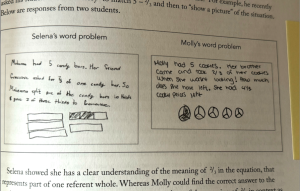Taking Action: Implementing Effective Mathematics Teaching Practices by DeAnn Huinker and Victoria Bill
The YouTube video for this episode
Welcome fellow Recovering Traditionalists to Episode 150: A Quick Math Story Problem Activity
Before I start this episode I’m going to read a positive comment. With all the negativity in the world it’s nice to hear nice things. Thank you for doing all you do out there to Build Math Minds & share what you are doing with me. When I get emails and comments on the YouTube channel that are THANK YOUs or just letting me know how you’ve used a video or resource of mine, it always brightens my day. If anything I’ve done has helped you and your students out, please email in and let us know. It’s info@buildmathminds.com. This week’s positivity comes from Amanda: “We homeschool and my 5 year old was struggling with counting on… until we did this worksheet one time!! One time was all it took for it to click for her! What a great tool!” This message came in reference to The Number of The Day worksheets. If you don’t have them yet, it’s a free download you can request over at https://buildmathminds.com/number-of-the-day-activities/ I know that’s a long one, so instead just fo to buildmathminds.com/150 and I’ll link up everything I mention in this episode.
In this week’s episode I’m giving you a quick activity you can do to see just how well your students understand the math operations and story problems.
In the book Taking Action: Implementing Effective Mathematics Teaching Practices by DeAnn Huinker and Victoria Bill I learned the term “reverse directionality” and how it’s used in math. Once they explained it I knew what it was but I’d never heard it called that. On page 133 they write:
“In the past he did not place much emphasis on contextual or visual representations, but now they play a central role in his teaching. One approach he often uses is to reverse directionality. He explained, ‘I ask students to create a context that would fit the number problem. Oftentimes this will cue me into whether or not the student understands the operation or is just trying to memorize a procedure.’ For example, he recently asked his students to ‘tell a story’ to match 5 – ⅔ and then to ‘show a picture’ of the situation.”
Typically in our textbooks, they give the contextual situation and often show a picture that goes with it then it asks the students to write the equation and solve it. Instead, give the students the equation and ask them to write a contextual story problem for that equation. And you can also have them create a picture for the problem.
In the book, they show a picture of two students’ work on the 5 – ⅔ equation and I’ll share that in the YouTube video over at youtube.com/buildmathminds if you’d like to see it, or on the podcast page buildmathminds.com/150 where I share all the links to resources I mention in the podcast.

The two student work examples they share, showed that it is important to have the students do both the story problem and the picture because sometimes kids understand how to solve the problem but they don’t know how to write it correctly in their story problem.
For the 5 – ⅔, Selena had written the story problem correctly saying “⅔ of ONE candy” but Molly had written “⅔ of the cookies”…however, in Molly’s picture you can see she actually only took ⅔ of ONE cookie. So if you just went off the story problem she wrote, you would think she doesn’t understand what it means to subtract ⅔ from 5 but in her picture you can see she actually does.
Solving an equation, writing a story problem, and drawing a visual representation of the problem are all unique skills and understandings. None of them show a full picture of a child’s understanding of the problem and so it’s important to give students opportunities to do all 3.
For a quick word problem activity, give your students an equation and just ask them to write a story problem. They don’t solve it, all they need to do is create a contextual problem for that equation and to add another layer, you can have them create a picture to go along with their story.
If you’d like links to the Number of the Day template, the book I referenced in this episode, and the YouTube channel you can find them all at BuildMathminds.com/150
If you do this activity with your students, come on over to this episode’s video on my YouTube channel at YouTube.com/buildmathminds and let me know in the comments how it went.
Until next week my Fellow Recovering Traditionalists, keep Building Math Minds.




